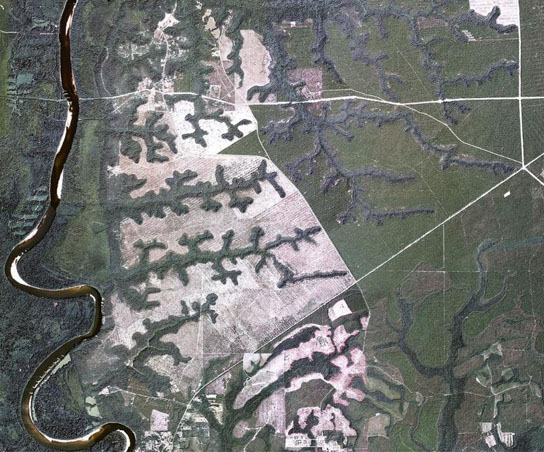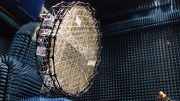
Aerial image of valley networks eroded by groundwater sapping into a sand plateau east of the Apalachicola River, near Bristol, Fla. Image is approximately 11 km wide. Credit: Taylor Perron/National Agriculture Imagery Program
Researchers in MIT’s Department of Earth, Atmospheric and Planetary Sciences (EAPS) have developed a mathematical model that gauges how fast the Apalachicola Bluffs and valleys are spreading. By measuring a hill slope profile, the researchers determined that you could figure out how fast the tips of the channels are growing.
From high above the Florida Panhandle, the Apalachicola Bluffs — a winding system of steep ravines — look like the branching veins of a leaf.
But this is a leaf in motion: Through the millennia, the ravines have worked their way east from the Apalachicola River, rippling through the land like furrows in a plowed field. This branching network is built on a shallow system of groundwater, with hundreds of valleys carved out over the years by streams and springs.
The Apalachicola Bluffs have been described as a living landscape, their sands constantly evolving and branching through a combination of shifting soil and flowing streams. Now researchers in MIT’s Department of Earth, Atmospheric and Planetary Sciences (EAPS) have developed a model that gauges how fast the area’s hills and valleys are spreading.
The researchers studied slopes at the very tips of the branching channels, which they refer to as “channel tips.” They found that the steeper a hill, the faster the channel tips are advancing across the landscape. The model, they say, can be used to predict the evolution of similar landscapes, such as retreating shorelines and the banks of large, meandering rivers.
“This is a speedometer for the growth of a channel network,” says Taylor Perron, the Cecil and Ida Green Assistant Professor of Geology in EAPS. “If you measure a hill slope profile, you can figure out how fast the tips of the channels are growing.”
Perron and co-author Jennifer Hamon ’10 will publish their results in an upcoming issue of the Journal of Geophysical Research.
Perron visited the Bluffs several years ago to participate in fieldwork led by Daniel Rothman, a professor of geophysics at MIT. The group hiked through the hilly terrain, observing that at the channel tips, steep hills gave way to valleys with springs at their bases. These springs form naturally when groundwater flows at shallow depths through the sandy hills: In the deepest valleys, the groundwater emerges as a trickle or a stream.
Previous researchers have found that these springs eat away at hills, transporting sand away from a hill’s base. In response, the sand on the hillside slides down to replace the sand that’s been displaced. Over the long term, the interaction between sand and water advances the valley tips outward across the landscape.
Perron and Hamon conjectured that the relationship between hills and springs may record how fast certain channel tips grow. The team focused specifically on the shapes of hillsides, studying the behavior of sand on slopes of varying steepness, and drawing up equations representing soil flux along slopes.
Through their equations, the team found that slopes that move faster across the landscape become steeper and more sharply curved. Perron inferred from the data that steep hills are created by strong, fast-moving springs.
The group tested their theory against topographic data obtained from Rothman’s research. In previous studies that related the growth of the valley network to groundwater flow, Rothman and his group examined data from airborne laser altimetry that mapped the Apalachicola Bluffs through the valleys’ dense vegetation. Perron and Hamon applied their equations to the various hill slopes along the map, assigning a relative speed to each advancing channel tip.
In the resulting map, the group identified some interesting patterns. For instance, Perron found that most of the fastest channel tips, consistent with Rothman’s groundwater studies, belonged to the same valley network, suggesting that this network grew more recently than the others. The older valleys, he says, appear to have slowed down as they grew closer to one another and the springs at their tips began to “compete” for water — a result consistent with Rothman’s groundwater studies. The more water available, the stronger a spring flows, cutting more sand from a hill.
The researchers also observed a second pattern superimposed on the map of channel-tip speeds: Southward-growing channel tips are bounded by steeper slopes, whereas gentler slopes surround channels that grow north. They say this discrepancy may be due to the sun: Southward-moving slopes — which face north — generally stay shadier and wetter, which may spur plant growth in the hot Florida climate, stabilizing the sandy soil.
“This is exciting, because we have no general theory that predicts how sunlight should shape topography,” Perron says. “But it’s clearly important. Plants lean towards the sun, but these slopes lean away.”
The group’s analysis may be used to characterize other regions with similar landscapes. Jon Pelletier, a professor of geosciences at the University of Arizona, has used similar mathematical modeling to study the valley networks of southern Arizona.
“The approach is applicable to a great many valley heads around the world where the valleys are ‘young,’” Pelletier says. “[The MIT researchers] have obtained an elegant mathematical relationship that characterized the shape of an important class of landforms.”
Perron adds, “This would be interesting in the context of floodplains … you might be able to use the bank curvature to estimate long-term rates of the migration of large rivers.”









Be the first to comment on "MIT Researchers Use Mathematical Model to Predict Speed of Spreading Valleys"